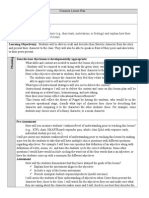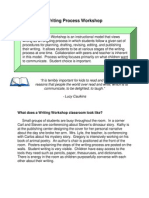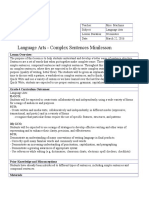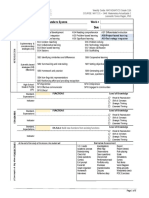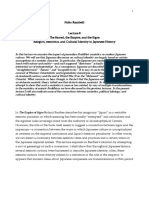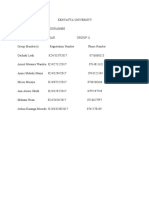Ask and Answer Questions About Key Details in A Text: Central Learning Focus
Ask and Answer Questions About Key Details in A Text: Central Learning Focus
Uploaded by
api-286879234Copyright:
Available Formats
Ask and Answer Questions About Key Details in A Text: Central Learning Focus
Ask and Answer Questions About Key Details in A Text: Central Learning Focus
Uploaded by
api-286879234Original Title
Copyright
Available Formats
Share this document
Did you find this document useful?
Is this content inappropriate?
Copyright:
Available Formats
Ask and Answer Questions About Key Details in A Text: Central Learning Focus
Ask and Answer Questions About Key Details in A Text: Central Learning Focus
Uploaded by
api-286879234Copyright:
Available Formats
.
Lesson Title
Students will write the steps of their How- To books by using transition words.
Discipline
Writing
Grade Level
1st Grade
Grouping
Class consists of 25 students. Students will work with partners and small groups will be formed based on prior
assessment of student writing
Students will sit in the meeting area while the teacher discusses tell across their fingers strategy while using transition
words.
Students will listen while the teacher reads a How-to book called A Salad Feast by
Students will listen while the teacher tells the students the steps of the teachers How-To book by using transition
words and using the across the finger strategy.
Students will turn and talk with their partners and describe their steps of their how to books using the across the
fingers strategy.
Class Organization/Class
Management:
Central Learning Focus
Central Focus
Content Standard
Students will be able to provide a how-to informational book and demonstrate knowledge of how to (i.e., procedural)
writing.
CCSS. ELA- LITERACY RI 1.1.: Ask and answer questions about key details in a text
CCSS.ELA-LITERACY.W.1.2 Write informative/explanatory texts in which they name their topic, supply facts about
the topic, and end with a sense of closure.
CCSS.ELA-LITERACY.W.1.5 With guidance and support from adults, focus on a topic, respond to questions and
suggestions from peers, and add details to strengthen writing as needed.
CCSS. ELA- LITERACY W.1.6: With guidance and support from adults, use a variety of digital tools to produce and
publish writing, including in collaboration with peers.
Student Learning
Goal(s)/Objective(s)
Prior Academic Knowledge
and Conceptions
Students will be able to sketch their steps to their how-to books.
Students will be able to state sequence steps to their how-to books to the rest of the class.
Students will be able to explain using academic language.
Prior knowledge of sequence and transition words.
Prior knowledge of using across the fingers strategy
Across the fingers strategy is an organized strategy to help the students state the steps of their how-to book
by using transition words and each finger represents a transition word. (i.e. thumb is First , index finger is
Academic Language
Demands
Differentiation/ Planned
Support
Next, middle finger is Then, ring finger is Last and the pinky finger is Finally)
The lesson will begin with the teacher and students recall the previous writing unit, when the students wrote
about personal narratives, such as an event in their life and used procedural writing to share their small
moments story with the class.
Students will be reminded that when they wrote their small moments, they used sequence words, such as
transitions words, a lead, an ending and details (e.g. action words, speech bubbles, labels).
Prior to the lesson, the teacher read The Pumpkin Book, by Gail Gibbons to the students and inside the text,
the author added a section called How to Carve a Pumpkin, where steps are displayed using transition
words to give the reader instructions on how to carve a pumpkin.
Transition words (e.g. first, next, then, last, finally)
Discuss
Sequence order
Write
State
Lead
Small moments
Details
The student who has an IEP will be grouped with 3 other students and also with the students
paraprofessional who will prompt transition words for the students.
Teacher will work with small groups providing a model of the use of transition words and using academic
language.
Struggling writers will be supported with transitional words and visual prompts to list the exact steps of their
procedure.
Chart of transitional words will be displayed
Across the fingers strategy will be displayed on the word wall
A model of procedural writing booklet will be provided and also a procedural list will be displayed.
Instructional Strategies and Learning Tasks
Resources and Materials
Launch
Pencils
Elmo
How to Booklet (blank)
1 chart paper called How to Write A How to Book displayed in front of the classroom
A completed model displaying How to Make Play-Doh in front of the classroom
A How to Book called A Salad Feast by
Print outs of How to Wash Your Hands; Examples of Bedtime Routine & Visual Schedule and How to
Carve a Pumpkin pictures.
Teacher will read a how-to book to the students called A Salad Feast by
Exploration
Structured Practice
Application
Student Feedback
Closure/Discussion
Teacher will demonstrate the steps that is being read to the students and explain how the teacher would add
transition words to this how-to book.
Connect to previous learning by showing a chart of ideas brainstormed in prior lessons
Through a think aloud model how to select the topic that the writer knows most about as a topic for a book
Model Think and Plan to show how to plan and write How-To book
Students will Think and Plan the steps to writing their How-to Books.
Students will think of the steps out loud while using the across my fingers strategies to help organize their
steps prior to writing their steps in their books.
Students will rehearse using across your fingers strategies with their carpet partner, as the listening partner
can try to imagine doing the activity.
Teacher will go around the classroom and listen to the students idea and assess students understanding.
Teacher will share some of the students ideas and also show the students a completed model of the
teachers how-to book that includes sketches and steps using transition words.
Teacher will provide the students with a large chart paper that is displaying the steps procedure the teacher
used in the teachers how-to book in front of the class.
Teacher will provide the students with leveled templates to help students write their steps to their how to
books.
Students will be able to choose which template they would like to use and return to their seats to begin writing
their steps to their how-to books.
Teacher will work with a small group and will provide transitional words and visual prompts to help students
list the exact steps of their procedural writing books.
Conference notes will be kept to inform teaching.
Students work will be collected and analyzed.
Students will apply what they learned about writing steps using transition words by describing and explaining
the steps that the student needs to know in order to teach their fellow classmates how to do something.
Students can read what they wrote down or explain it to the class without using what is written down.
During the time the students are working individually, go around the room to see how each student is doing.
Make sure to observe if the students are using transition words in their steps and that their steps are in
sequential order.
Once the students have completed their steps have the students share what they have written down with the
class and provide verbal feedback to the students.
Once students have finished discussing and sharing their steps ask and answer any questions if needed.
Collection of students work to determine if the students meet the learning objective.
Academic Language Demand(s)
Academic Language
Group discussion
Transition words(first, next, then, last, finally)
Language Functions
Engagement
Student Support
Sequence order
Lead
Small Moments
Details
The knowledge that students should have is being able to help each other if it is needed.
How to describe and write procedural books using transitions words.
How to write procedural books in a sequential order
Students will use listening during the group discussion and share circle when the students are sharing their
ideas and steps to their books.
Students will use writing when they are writing their steps on the booklet that is provided to them.
Students will use speaking when they are discussing and sharing their ideas and steps of their books.
The teacher will provide a model of a how-to book using academic language, sketches and transition words.
A chart will be displayed showing the students how to write a how to book, with writing and visual effects on
the chart along with vocabulary words listed.
Students will be able to support each other by sharing their ideas using transition words.
Assessments
Expectations of Student
Learning
Type and description of
assessment (summative
and formative, informal and
formal)
Modifications to the
assessment so that all
students could
demonstrate their learning
Evaluation Criteria of Data
I expect the students will be able to complete the steps of their how-to books.
I expect the students will be able to work and communicate with other students at their table and during the
group discussion.
Students will be able to write all the steps of their how-to book or a few steps to their how-to books.
I will document observations of students work and student share time to determine if the students made
progress and meet the expectations.
Students will be assessed by students written work.
Teachers notes during the lesson
Observations of partnerships if students requested help from a fellow classmate.
Provide written models of what is to be done.
Small group work with either the teacher or the paraprofessional in the classroom to support the struggling
students.
Differentiate the handout the students are to use when writing their steps. (e.g. handouts will have the
transition words listed on them)
Use small moments pieces as pre-assessment
The assessments would be able to provide me with evidence on whether students understood the material that
was taught or if they had trouble with the material being discussed.
Since the students have worked on writing procedural writing in their small moments books, I should be able to
see if the students were able to write their steps successfully or not based on the individual work provided by
the student
A check list titled How did I do? will be provided to the students to help the students complete their how-to
books.
A rubric for completed piece
An extension activity will include having students retell stories from their own how-to books. Students can actually work together to turn
into life their own how-to creation.
You might also like
- Chicka Chicka Boom Boom Project Lesson PlanDocument5 pagesChicka Chicka Boom Boom Project Lesson Planapi-236986052100% (1)
- Important Concepts in Purposive CommunicationDocument6 pagesImportant Concepts in Purposive CommunicationRuel Potentiano Basa100% (2)
- mq2 CSTP Lesson Plan TemplateDocument4 pagesmq2 CSTP Lesson Plan Templateapi-646051032No ratings yet
- Speaking and Listening Lesson PlanDocument4 pagesSpeaking and Listening Lesson Planapi-296333288No ratings yet
- Reflective Lesson Plan 6Document7 pagesReflective Lesson Plan 6api-252760395No ratings yet
- Shellnutt Lesson Plan 4Document5 pagesShellnutt Lesson Plan 4api-341480465No ratings yet
- Teaching TeenagersDocument23 pagesTeaching TeenagersDyana Colinette100% (2)
- Ask and Answer Questions About Key Details in A Text: CCSS - ELA-LITERACY.W.1.5Document4 pagesAsk and Answer Questions About Key Details in A Text: CCSS - ELA-LITERACY.W.1.5api-286879234No ratings yet
- Ask and Answer Questions About Key Details in A Text: Central Learning FocusDocument4 pagesAsk and Answer Questions About Key Details in A Text: Central Learning Focusapi-286879234No ratings yet
- Blog Post Lesson PlanDocument3 pagesBlog Post Lesson Planccaruso18No ratings yet
- Reflective Lesson Plan Model Rubric - 450 - Revised 2013Document7 pagesReflective Lesson Plan Model Rubric - 450 - Revised 2013dburns1No ratings yet
- Calk Ins WritingDocument9 pagesCalk Ins WritingNoelia VillagraNo ratings yet
- Modified Lesson Plan A 5Document6 pagesModified Lesson Plan A 5api-242533177No ratings yet
- Field Experience Lesson PlanDocument10 pagesField Experience Lesson Planapi-547691924No ratings yet
- Millicent Atkins School of Education: Common Lesson Plan TemplateDocument6 pagesMillicent Atkins School of Education: Common Lesson Plan Templateapi-382117266No ratings yet
- English Language Lesson Plan Feb 10Document3 pagesEnglish Language Lesson Plan Feb 10Vasseon Pondi-endz RoyeNo ratings yet
- Lesson Plan Chase Rajala Quarter 3Document5 pagesLesson Plan Chase Rajala Quarter 3api-691073203No ratings yet
- PLC ProjectDocument9 pagesPLC Projectapi-531717294No ratings yet
- Standard 8 With ArtifactsDocument10 pagesStandard 8 With Artifactsapi-283389640No ratings yet
- Punctuation Mark Lesson PlanDocument4 pagesPunctuation Mark Lesson Planapi-29633328867% (3)
- Lesson Plan 2 Chase Rajala 1Document4 pagesLesson Plan 2 Chase Rajala 1api-691073203No ratings yet
- Big Ideas/Take-Home Message: Peer Feedback November 9, 2016 Grade 6 Language ArtsDocument7 pagesBig Ideas/Take-Home Message: Peer Feedback November 9, 2016 Grade 6 Language Artsapi-340433421No ratings yet
- Lesson Plan 6Document6 pagesLesson Plan 6api-317480573No ratings yet
- ps1 Language Arts Lesson 1Document3 pagesps1 Language Arts Lesson 1api-264154243No ratings yet
- Kindergarten Writing Lesson PlanDocument7 pagesKindergarten Writing Lesson Planapi-332051194No ratings yet
- Millicent Atkins School of Education: Common Lesson Plan TemplateDocument10 pagesMillicent Atkins School of Education: Common Lesson Plan Templateapi-346719524No ratings yet
- Lesson 5 - Entertaining BeginningsDocument4 pagesLesson 5 - Entertaining BeginningsAnonymous Z9zcD6BzNo ratings yet
- Lesson Plan Template: NEPF + Components of An Effective Lesson HybridDocument4 pagesLesson Plan Template: NEPF + Components of An Effective Lesson Hybridapi-286066914No ratings yet
- 426 Lesson 1Document4 pages426 Lesson 1api-427867861No ratings yet
- Lesson 9Document4 pagesLesson 9api-335913623No ratings yet
- Sample Lesson PlanDocument10 pagesSample Lesson Planapi-356344648No ratings yet
- Direct Instruction Lesson Plan TemplateDocument3 pagesDirect Instruction Lesson Plan Templateapi-282747311No ratings yet
- Nancy Levit EditsDocument5 pagesNancy Levit Editsty70001No ratings yet
- Ela Edtpa LessonDocument5 pagesEla Edtpa Lessonapi-313445058No ratings yet
- Millicent Atkins School of Education: Common Lesson Plan Template PlanningDocument9 pagesMillicent Atkins School of Education: Common Lesson Plan Template Planningapi-331892318No ratings yet
- Millicent Atkins School of Education: Common Lesson Plan TemplateDocument12 pagesMillicent Atkins School of Education: Common Lesson Plan Templateapi-346302593No ratings yet
- Class Manag PFDocument8 pagesClass Manag PFMarya GuennanNo ratings yet
- Lesson Phase Pirate HatDocument1 pageLesson Phase Pirate Hatapi-254797511No ratings yet
- Language Arts Instruction Lesson PlanDocument5 pagesLanguage Arts Instruction Lesson Plancedes414No ratings yet
- Reading Lesson PlanDocument8 pagesReading Lesson Planapi-346286339No ratings yet
- Lesson Plan Observation 1Document6 pagesLesson Plan Observation 1api-702381076No ratings yet
- t3l RJG CommentsDocument4 pagest3l RJG Commentsapi-242609249No ratings yet
- Complex Sentences Lessonplan1Document7 pagesComplex Sentences Lessonplan1api-310531318No ratings yet
- Reading Group Lesson PlanDocument3 pagesReading Group Lesson Planapi-477255988No ratings yet
- Rhyming PoemsDocument5 pagesRhyming Poemsapi-364966158No ratings yet
- Grade Level: 4 Lesson Duration: 2 Hours: "Three Young Pilgrims" Poetry Challenge MOPTA Lesson Plan FormatDocument19 pagesGrade Level: 4 Lesson Duration: 2 Hours: "Three Young Pilgrims" Poetry Challenge MOPTA Lesson Plan Formatapi-341318966No ratings yet
- Persuasive Writing: Final Project - Individual WorksheetDocument5 pagesPersuasive Writing: Final Project - Individual Worksheetapi-314247862No ratings yet
- Literacy Rotation Lesson Plan 2 1Document4 pagesLiteracy Rotation Lesson Plan 2 1api-318698223No ratings yet
- Lesson Plan Form Teacher Education Department CSUDH Vocabulary and ComprehensionDocument4 pagesLesson Plan Form Teacher Education Department CSUDH Vocabulary and Comprehensionapi-331077824No ratings yet
- Project 4 Lesson Task 1Document11 pagesProject 4 Lesson Task 1api-547286871No ratings yet
- Lesson PlanDocument4 pagesLesson Planapi-220292228No ratings yet
- 1-Scoe Lesson Planning Template Fa23 2 1Document5 pages1-Scoe Lesson Planning Template Fa23 2 1api-583052012No ratings yet
- q2 CSTP Lesson Plan TemplateDocument4 pagesq2 CSTP Lesson Plan Templateapi-646239786No ratings yet
- Eddn 637 - Siop LessonDocument8 pagesEddn 637 - Siop Lessonapi-710356152No ratings yet
- My Best LessonDocument19 pagesMy Best Lessonapi-665035697No ratings yet
- Eagleston Allison Siop Lesson PlanDocument4 pagesEagleston Allison Siop Lesson Planapi-552414715No ratings yet
- Instructional Foundations The First Poem LessonDocument4 pagesInstructional Foundations The First Poem Lessonapi-303076802No ratings yet
- Unit The Real Numbers System Week # Lesson Date: AS8 Project-Based Learning AS9 Technology IntegrationDocument9 pagesUnit The Real Numbers System Week # Lesson Date: AS8 Project-Based Learning AS9 Technology IntegrationLeonardo Torres PaganNo ratings yet
- OverviewDocument7 pagesOverviewapi-297259056No ratings yet
- A Reflection On The Use of NeuroDocument6 pagesA Reflection On The Use of NeuroIsai AlmanzaNo ratings yet
- Humphrey 2011 PDFDocument5 pagesHumphrey 2011 PDFŁinzZè KrasniqiNo ratings yet
- Lecture On The Empire of Signs PDFDocument31 pagesLecture On The Empire of Signs PDFpaul de leeuwNo ratings yet
- Testing, Assesing and TeachingDocument16 pagesTesting, Assesing and TeachingNysrogh AndreiNo ratings yet
- Republic of The Philippines Department of Education: Tugbo Integrated SchoolDocument2 pagesRepublic of The Philippines Department of Education: Tugbo Integrated SchoolJemuel Castillo100% (1)
- Organization and Management - Syllabus 2016-2017Document7 pagesOrganization and Management - Syllabus 2016-2017Salve de la Paz100% (1)
- In Marathi.Document8 pagesIn Marathi.Anonymous CwJeBCAXpNo ratings yet
- Quiz-Assignment For Understanding The SelfDocument2 pagesQuiz-Assignment For Understanding The SelfAsuna YuukiNo ratings yet
- Behaviour CounsellingDocument12 pagesBehaviour CounsellingSharum HussinNo ratings yet
- Last Name First Name MI: BooksDocument8 pagesLast Name First Name MI: BooksPauline PascuaDNo ratings yet
- TC Lesson Plan Scarlet IbisDocument4 pagesTC Lesson Plan Scarlet Ibisapi-5194630370% (1)
- Healthy Self 1Document11 pagesHealthy Self 1Riean Shantle100% (1)
- Post Traumatic Stress Disorder PTSD FactsheetDocument26 pagesPost Traumatic Stress Disorder PTSD Factsheethalima mahmood100% (1)
- Pangasinan State University COLLEGE OFDocument10 pagesPangasinan State University COLLEGE OFAyessa Joy GarciaNo ratings yet
- Beauty Care (Skin) Services NC IIDocument193 pagesBeauty Care (Skin) Services NC IIJoselito B GerlingoNo ratings yet
- HRM - Unit 2 - PPT - VJDocument14 pagesHRM - Unit 2 - PPT - VJVijay prasadNo ratings yet
- Learning Episode 15: Field StudyDocument4 pagesLearning Episode 15: Field StudyChristian Elorde100% (1)
- Models of Clinical Supervision - For C7834Document19 pagesModels of Clinical Supervision - For C7834David Moore, PhD CDP100% (2)
- Ucsp Report (Becoming A Member of The Society)Document3 pagesUcsp Report (Becoming A Member of The Society)Dwyne Kaiser GallegoNo ratings yet
- Thesis Maher e 2Document451 pagesThesis Maher e 2reenakini674717No ratings yet
- Effective Lesson Planning and Classroom Management SuggestionsDocument3 pagesEffective Lesson Planning and Classroom Management SuggestionsChery BlossomNo ratings yet
- Mapeh G-9 1Document5 pagesMapeh G-9 1Hannah Daganta CanalitaNo ratings yet
- Growing Leaders Certificate Cat 1Document4 pagesGrowing Leaders Certificate Cat 1Ann OkothNo ratings yet
- The Teacher As A Role ModelDocument1 pageThe Teacher As A Role ModelOSONDU JUDE THADDEUSNo ratings yet
- Philosophy of Mind and The Mind Body ProblemDocument68 pagesPhilosophy of Mind and The Mind Body ProblemRejaneFAraujoNo ratings yet
- Work Ethic: What Is It and How Do I Get Some?Document23 pagesWork Ethic: What Is It and How Do I Get Some?liwayway b. raymundoNo ratings yet
- International Organizational BehaviorDocument19 pagesInternational Organizational BehaviorMaricel BuenoNo ratings yet
- Bhagavad GitaDocument82 pagesBhagavad Gitasonalpatil09No ratings yet
- IALP ProgammaDocument244 pagesIALP ProgammaMarco CicioNo ratings yet



